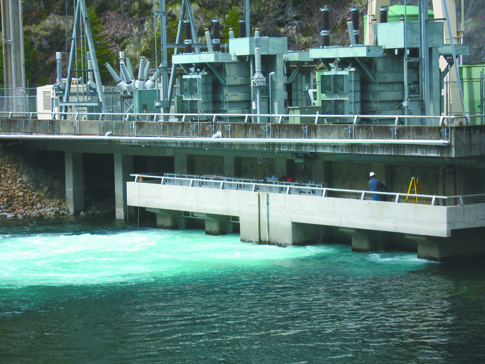Related News
Related News
-
EWEB secures $2.5 billion of reliable, affordable, carbon-free energy for customers
The new contract with EWEB’s largest energy supplier, the Bonneville Power Administration, forms the foundation of a diverse energy portfolio.
Find Out More -
Women in STEM: Meet the Hydro Project Engineer Building Habitat for Salmon
EWEB Engineer Associate Val Chang found her way to the McKenzie River from Los Angeles, inspired by heritage trips to the waters of Taiwan and key mentors along the way.
Find Out More -
Public Power Week Poster Contest Winners 2025
The results are in! View the winning posters from EWEB's 2025 Public Power Week Poster Contest.
Find Out More -
EWEB Hometown Heroes compete internationally
Out of 290 teams from 14 different countries, EWEB's Lineman Rodeo team places in the top third of competitors.
Find Out More -
Vote for your favorite Public Power Week Posters
The top five submittals will receive awards. Help us pick the winners.
Find Out More -
Electric Projects underway in North & South Eugene
Underground lines and disaster-resilient power poles are part of EWEB’s infrastructure upgrade near Eugene’s largest natural resource area.
Find Out More -
The Bonneville Power Administration Rate Change and Your EWEB Bill
BPA’s finalized rate increase is smaller than projected, and EWEB’s pass-through adjustment effective October 1, 2025 will now be 2.7% for residential customers—down from the anticipated 4%.
Find Out More -
EWEB completes helicopter installation of salmon habitat features
EWEB adds downed trees and 2,000 tons of gravel to the Uupper McKenzie River below Tamolitch Falls to improve spawning habitat.
Find Out More -
Court rules in favor of EWEB in Carmen-Smith litigation
The U.S. District Court in Eugene has granted EWEB's motion to dismiss a lawsuit brought under the Endangered Species Act pertaining to fish passage at EWEB’s Trail Bridge Dam. The favorable ruling clears the way for EWEB to continue advancing towards implementation of permanent fish passage at the dam.
Find Out More -
EWEB proposes modified plan for permanent fish passage at Trail Bridge Dam
After eight months of extensive collaboration and analysis with scientific experts at two federal regulatory agencies, EWEB is proposing an improved plan to build permanent fish passage facilities at Trail Bridge Dam on the McKenzie River.
Find Out More -
EWEB prepares for wildfire season with risk mitigation measures
EWEB is building a more resilient electric system to weather various types of disasters, from wildfire to winter storms.
Find Out More -
EWEB, Lane County host open house to gather feedback for “Leaburg Transportation Alternatives Analysis”
“What is the Future of the Leaburg Dam Bridge?” open house exhibit on display at Lloyd Knox Park Visitor Pavilion through July 25
Find Out More -
Improving habitat resiliency throughout the Upper McKenzie
Environmental Responsibility is a core guiding value for EWEB decision-making. This summer, EWEB continues its commitment to environmental stewardship with a robust slate of habitat enhancement updates throughout the upper McKenzie River, across the footprint of the Carmen-Smith Hydroelectric Project.
Find Out More -
EWEB weighs multi-billion-dollar decision affecting energy supply
EWEB is weighing energy supply decisions that will cost nearly $2 billion over the next two decades.
Find Out More -
Walterville Hydroelectric Project to remain offline through 2025
EWEB continues to pursue repair plans but must fulfill additional investigation requirements before resuming operation.
Find Out More - Show More
EWEB Receives New 40-Year License for Carmen-Smith
May 21, 2019

The Eugene Water & Electric Board has received a new 40-year operating license for our largest utility-owned generation facility - the Carmen-Smith Hydroelectric Project on the upper McKenzie River.
The new license, issued by the Federal Energy Regulatory Commission, will allow us to operate the carbon-free, renewable hydroelectric facility through at least May 2059. The project generates enough electricity to power nearly 16,000 homes.
"We are thrilled to receive this new license and our team is looking forward to continuing to modernize the facilities at the project," said Patty Boyle, principal project manager for EWEB.
In anticipation of the new federal operating license, we started a major rebuild of the Carmen Powerhouse in 2017, replacing and refurbishing much of the equipment first installed in 1963 when the project opened. Last year, we replaced two giant turbine shut-off valves that measure 9 feet in diameter and weigh more than 26 tons. In April, we started a complete rebuild of the Carmen Substation, including the replacement of substation transformers weighing more than 66 tons each. In 2020 and 2021, we will replace the turbine runners (the propeller-like structures that spin with water pressure) and generators at the powerhouse.
"The issuance of this license initiates a substantial investment in the project along with many environmental and recreational improvements," Boyle said. "We'll be investing in fish passage facilities, improving spawning habitat and rebuilding three campgrounds."
Over the next several years, we will spend more than $116 million on upgrading the powerhouse and substation, rebuilding the three campgrounds (Ice Cap, Trail Bridge and Lakes End) in addition to other recreational, environmental and habitat improvements.
Carmen-Smith is a carbon-free generation resource known as a "peaking plant" that allows us to ramp up and down to meet customers' peak energy needs. It is one of three EWEB-owned generating facilities on the McKenzie River that supplies reliable electricity for our customer-owners.
Carmen-Smith is a network of three dams and reservoirs and two power-generating units located 71 miles east of Eugene. The Carmen Diversion Reservoir, filled by the McKenzie River flowing from its headwaters at Clear Lake, has minimal storage capacity and is used to divert water into an 11,300-foot-long tunnel leading to Smith Reservoir. From Smith Reservoir, water is routed through a second, 7,325-foot-long tunnel to the Carmen Power Plant, which discharges into Trail Bridge Reservoir, and then flows through the Trail Bridge power plant and back into the McKenzie River below Trail Bridge Dam.

